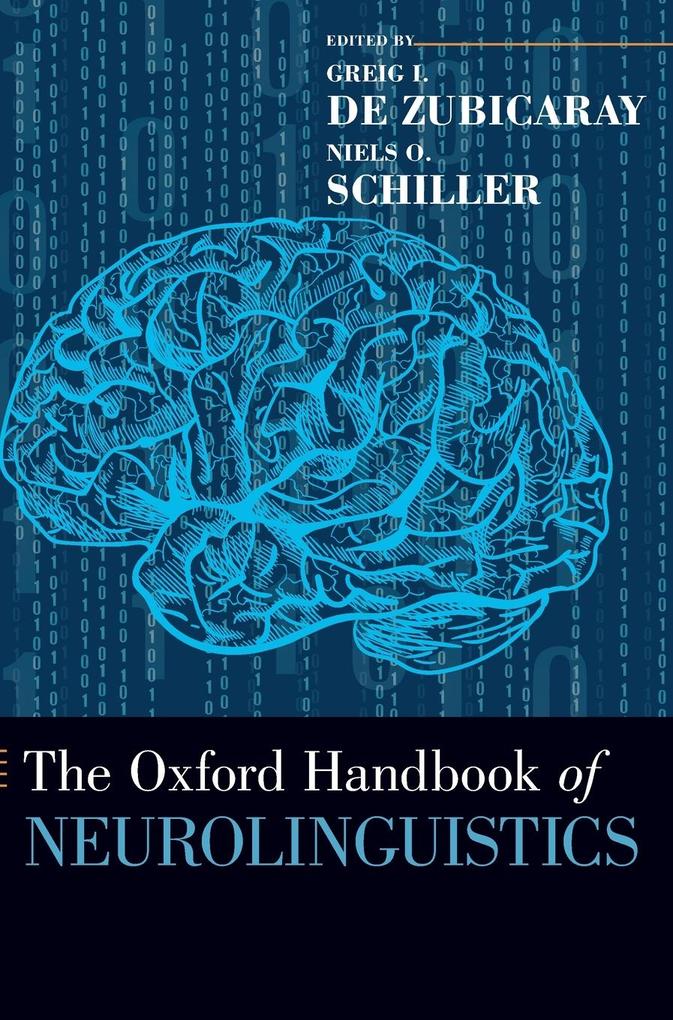NEU: Das eBook.de Hörbuch Abo - jederzeit, überall, für nur 7,95 € monatlich!
Jetzt entdecken
mehr erfahren
Zustellung: Do, 02.10. - Mi, 08.10.
Versand in 2 Wochen
VersandkostenfreiNeurolinguistics is a highly interdisciplinary field, drawing on linguistics, psychology, neurology, and cognitive neuroscience. Neurolinguistics, like psycholinguistics, covers aspects of language processing; but unlike psycholinguistics, it draws on data from patients with damage to language processing capacities, or the use of modern neuroimaging technologies such as fMRI, TMS, or both. The burgeoning interest in neurolinguistics reflects the fact that anunderstanding of the neural bases of this data can inform more biologically plausible models of the human capacity for language. The Oxford Handbook of Neurolinguistics provides concise overviews of this rapidly-growing field, and engages an audience with an interest in the neurobiology oflanguage.
Inhaltsverzeichnis
- Contributors
- Preface
- Greig I. de Zubicaray and Niels O. Schiller
- 1. Neurolinguistics: A Brief Historical Perspective
- Sheila E. Blumstein
- Section I The Methods
- 2. Neurolinguistic Studies of Patients with Acquired Aphasias
- Stephen M. Wilson
- 3. Electrophysiological Methods in the Study of Language Processing
- Michelle Leckey and Kara D. Federmeier
- 4.Studying Language with functional Magnetic Resonance Imaging (fMRI)
- Stefan Heim and Karsten Specht
- 5. Transcranial Magnetic Stimulation (TMS) to Study the Neural Network Account of Language
- Teresa Schuhmann
- 6. Magnetoencephalography (MEG) and the Cortical Dynamics of Language Processing
- Riitta Salmelin, Jan Kujala, Mia Liljeström
- 7. Shedding light on language function and its development with optical brain imaging
- Yasuyo Minagawa and Alejandrina Cristia
- 8. What has direct cortical and subcortical electrostimulation taught us about neurolinguistics?
- Hugues Duffau
- 9. Diffusion imaging methods in language sciences
- Stephanie Forkel and Marco Catani
- Section II Development and Plasticity
- 10.Neuroplasticity: Language and emotional development in children with perinatal stroke
- Judy S. Reilly and Lara R. Polse
- 11.The neurolinguistics of bilingualism
- David W. Green and Judith F. Kroll
- 12. Language and ageing
- Jonathan Peelle
- 13. Language plasticity in epilepsy
- Jeffrey Cole and Marla J. Hamberger
- 14. Language Development in Deaf Children: Sign Language and Cochlear Implants
- Aaron Newman
- Section III Articulation and Production
- 15. Neurocognitive organisation of the articulatory and motor processes of speech
- Pascale Tremblay, Isabelle Deschamps, and Anthony S. Dick
- 16. The Neural Organization of Signed Language: Aphasia and Neuroscience Evidence
- David P. Corina and Laurel A. Lawyer
- 17.Understanding how we produce written words: Lessons from the brain
- Brenda Rapp and Jeremy Purcell
- 18.Motor speech disorders
- Wolfram Ziegler, Theresa Schölderle, Ingrid Aichert, and Anja Staiger
- 19.Investigating the spatial and temporal components of speech production
- Greig de Zubicaray and Vitoria Piai
- 20. The Dorsal Stream Auditory-Motor Interface for Speech
- Greg Hickok
- Section IV Concepts and Comprehension
- 21. Neural representations of concept knowledge
- Andrew J. Bauer and Marcel A. Just
- 22.Finding concepts in brain patterns: From feature lists to similarity spaces
- Elizabeth Musz and Sharon L. Thompson-Schill
- 23.The Organization of Manipulable Object Concepts in the Human Brain
- Frank Garcea and Bradford Mahon
- 24.Neural Basis of Monolingual and Bilingual Reading
- Pedro M. Paz-Alonso, Myriam Oliver, Ileana Quiñones and Manuel Carreiras,
- 25.Dyslexia and its Neurobiological Basis
- Kaja Jasinska and Nicole Landi
- 26.Speech perception: a perspective from lateralisation, motorisation, and oscillation
- David Poeppel, Greg Cogan, Ido Davidesco, Adeen Flinker
- 27.Sentence processing: towards a neurobiological approach
- Ina Bornkessel-Schlesewsky and Matthias Schlesewsky
- 28.Comprehension of metaphors and idioms: an updated meta-analysis of functional magnetic resonance imaging studies
- Alexander M. Rapp
- 29.Language comprehension and emotion: Where are the interfaces, and who cares?
- Jos J.A. van Berkum
- Section V Grammar and Cognition
- 30.Grammatical categories
- David Kemmerer
- 31.Neurocognitive mechanisms of agrammatism
- Cynthia Thompson and Jennifer Mack
- 32.Verbal working memory
- Bradley Buchsbaum
- 33.Subcortical contributions to language
- David Copland and Anthony Angwin
- 34.Lateralisation of language
- Lise Van der Haegen and Qing Cai
- 35.Neural mechanisms of music and language
- Mattson Ogg and L. Robert Slevc
Mehr aus dieser Reihe
Produktdetails
Erscheinungsdatum
01. April 2019
Sprache
englisch
Seitenanzahl
990
Reihe
Oxford Handbooks
Herausgegeben von
Greig I de Zubicaray, Niels O Schiller
Verlag/Hersteller
Produktart
gebunden
Gewicht
2064 g
Größe (L/B/H)
249/175/61 mm
ISBN
9780190672027
Entdecken Sie mehr
Bewertungen
0 Bewertungen
Es wurden noch keine Bewertungen abgegeben. Schreiben Sie die erste Bewertung zu "Oxford Handbook of Neurolinguistics" und helfen Sie damit anderen bei der Kaufentscheidung.
































